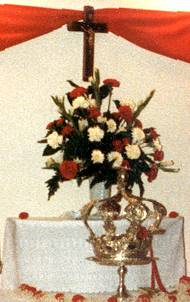

Holy Ghost Feast Origin and TraditionThe Portuguese Feast of the Holy Ghost is a tradition of adoration to the third person of the Blessed Trinity. The feast and its traditions were modeled after the example set by Queen Isabella (or Elizabeth) of Portugal (1271-1336). Queen Isabella, who was canonized in 1626, was devoted to the Holy Spirit and works of charity to the poor and sick. Portuguese folklore indicates that the Queen would carry food out of the castle under her cloak. Her husband, King Denis, asked to see what she carried under her cloak. As she removed the bread, it had miraculously turned into a bouquet of roses and she was never again questioned. She would give the poor "pensaos" which
consisted of meat, bread, and wine which they took home to The Two colors are used in conjunction with the feast: red and white. Red symbolizes the tongues of fire, the form in which the Holy Spirit descended on the Apostles, and white symbolizes peace, purity and divinity. The seven gifts of the Holy Spirit are symbolized by our seven weeks (domingas) of adoration from Easter Sunday through Pentecost Sunday. 
The Crown, symbolizing the Holy Spirit, is delivered to each "dominga" family for one week beginning on Easter Sunday. During each families week of hosting the Holy Spirit, their home is open to the public and at 8:00 PM the rosary is recited in front of their altar. Following the recitation of the rosary, the traditional Portuguese sweetbread (massa), wine, and other refreshments are served. At the completion of each week, the dominga family returns to 10:00 mass in a cortege. Immediately following mass, the cortege forms on the altar for the "crowning" ceremony. After mass, the cortege travels to the next dominga home and presents the family with the crown, beginning their week. The eighth and final dominga of the year is at the Mordomo’s home from Sunday through Friday evening. The two days of the feast are the highlight of this beautiful tradition. On Saturday, the eve of Trinity Sunday, the crown is moved to the Holy Ghost Hall (Fenner Avenue). On that evening a roast beef dinner is served prior to recitation of the rosary and musical entertainment ends the evening. On Trinity Sunday all the dominga families process from Holy Ghost Hall to church for the final crowning of the year at 10:00 mass. After mass, all eight corteges, joined by bands and invited guests, march in procession back to Holy Ghost Hall. Traditional "sopas" (Portuguese soup) and roast beef are served to all attending, in like manner to Saint Isabella serving her subjects. The entire Feast day is filled with devotion and unity. The Feast celebration officially ends after selection of the seven dominga names and the announcement of the new Mordomo. Be sure to check the photo albums and movies for photos and movies of past feasts. |